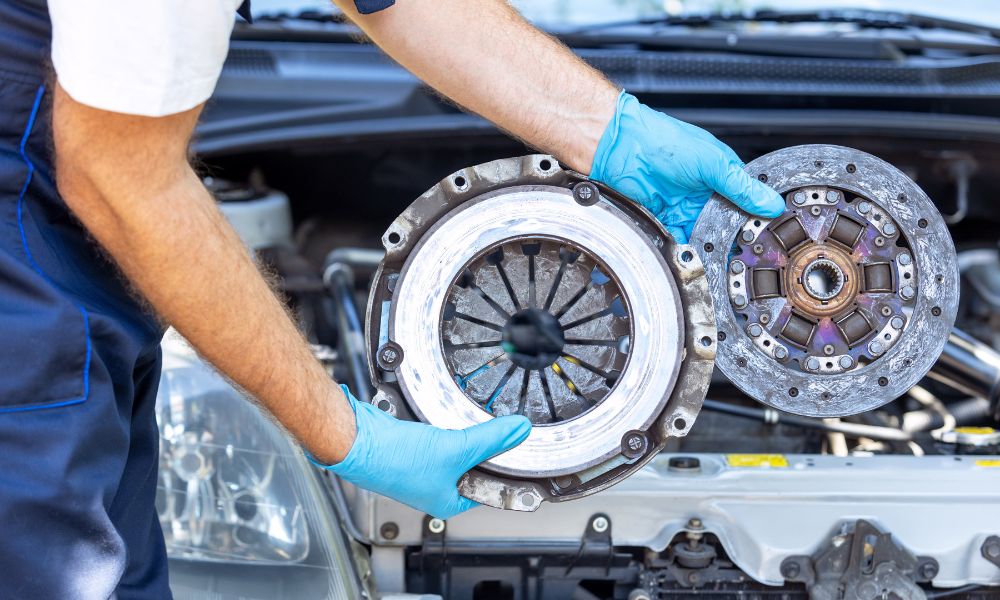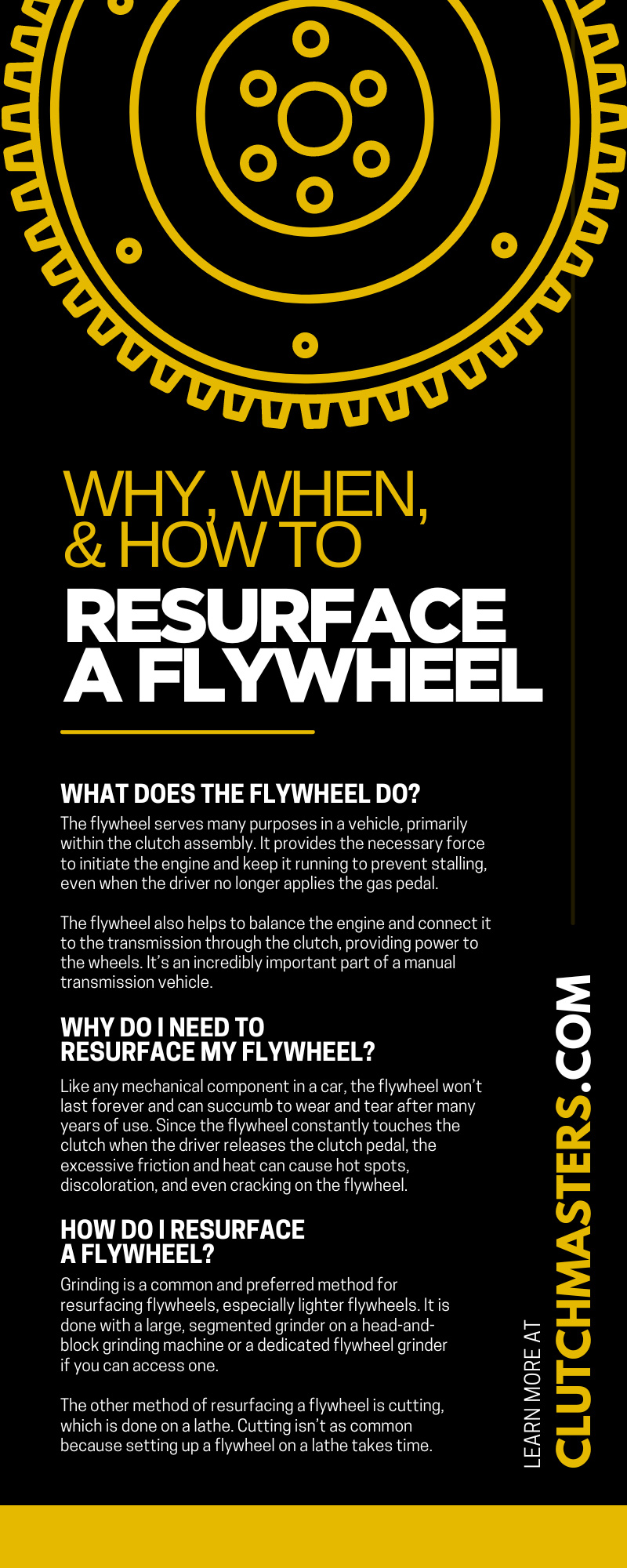Why, When, & How To Resurface a Flywheel

One of the most important maintenance tasks for a vehicle’s clutch assembly is resurfacing the flywheel. Without the occasional resurfacing, a vehicle’s flywheel can degrade to the point that it becomes dangerous to drive. We’ll explain the why, when, and how for resurfacing a flywheel so drivers know how and when to care for their vehicle’s flywheel.
What Is a Flywheel?
Before we get into the why, when, and how, let’s get on the same page about flywheels. The flywheel is integral to the clutch assembly and your vehicle’s engine. This large metal disc is typically made of cast iron, steel, or aluminum. The flywheel has teeth on its edges that grab onto the starter motor, which is located between the clutch and the engine in the transmission bell housing.
What Does the Flywheel Do?
The flywheel serves many purposes in a vehicle, primarily within the clutch assembly. It provides the necessary force to initiate the engine and keep it running to prevent stalling, even when the driver no longer applies the gas pedal.
The flywheel also helps to balance the engine and connect it to the transmission through the clutch, providing power to the wheels. It’s an incredibly important part of a manual transmission vehicle.
Why Do I Need To Resurface My Flywheel?
Like any mechanical component in a car, the flywheel won’t last forever and can succumb to wear and tear after many years of use. Since the flywheel constantly touches the clutch when the driver releases the clutch pedal, the excessive friction and heat can cause hot spots, discoloration, and even cracking on the flywheel.
Hopefully, your flywheel never succumbs to that, but it’s always possible. If you inspect the clutch assembly and flywheel and notice discoloration or cracking, you need to resurface or replace your vehicle’s flywheel. Driving with a worn-down flywheel is difficult, unsafe, and can cause significant problems for other components in your vehicle.
Resurfacing a steel flywheel applies to many factory single mass flywheels that are equipped in the car from the manufacturer or any of our aftermarket performance flywheels. We do not recommend or advise surfacing a dual-mass flywheel. Instead, replace it with a factory component, or better yet, one of our performance flywheels and clutch kits! If you have one of our lightweight aluminum flywheels, you don’t need to worry about resurfacing the flywheel. You can replace the steel insert that our aluminum flywheels contain.
When Do I Need To Resurface My Flywheel?
Resurfacing a flywheel isn’t like rotating your vehicle’s tires on a recommended schedule or calendar time. You’ll have to inspect the flywheel regularly or look out for the following signs of a compromised or failing flywheel.
The Gears Are Slipping
One of the most common signs of a worn-down or distorted flywheel is slipping gears. Gear slippage occurs when the engine revs like it’s accelerating, but the power isn’t transferred to the wheel. When this happens, it feels like your car is spinning its wheels while stuck in the mud.
This comes from the clutch not engaging with the assembly because it’s overheated, warped, or too worn down. If your vehicle’s gears are slipping, you should check the flywheel and clutch assembly immediately.
Is Something Burning?
It’s never a good sign when you smell something burning in your vehicle. If the burning odor smells like metal-on-metal, it could be the flywheel.
Intense friction between the clutch disc and the flywheel assembly can cause high temperatures and a burning smell. If the flywheel is the source of the burning smell, you should resurface or replace it immediately before it fails. If you neglect this problem, the clutch disc and flywheel will continue to overheat until an eventual failure that could be catastrophic for your vehicle’s transmission. If you do have an issue with your flywheel and it needs to be resurfaced or replaced, we strongly advise replacing the clutch at the same time, as the clutch is likely compromised.
The Clutch Shudders
If the clutch shudders or vibrates, also known as clutch chatter, there’s possibly something wrong with the clutch and potentially the flywheel. Typically, clutch chatter occurs when the driver tries to accelerate, but the clutch struggles to engage the flywheel.
Clutch chatter is never a good sign, but sometimes it is unavoidable, especially if you are using one of our high-performance clutch kits like the FX400 single disc clutch kits or our twin disc clutch kits. Because of the nature of these clutch kits and the way they engage instantaneously, it is sometimes impossible to avoid clutch chatter if you accelerate or reverse from a stop.
Cracks on the Flywheel
If you notice significant signs of wear and tear, like cracking or blisters, when inspecting the flywheel, that’s a major red flag. Heat cracks mean the flywheel has been experiencing much more thermal stress than it can handle, absorb, and dissipate safely.
A cracked flywheel is beyond saving and near total failure and should be replaced.
How Do I Resurface a Flywheel?
If your flywheel exhibits any of these signs, you should resurface or replace it immediately. Resurfacing is much more affordable than replacing. We are happy to help you resurface a flywheel, and it’s something we do every day. Of course, if you need a replacement flywheel, we can help with that, too!
You can resurface a flywheel in two ways, depending on the type of flywheel the vehicle uses: grinding or cutting.
Grinding
Grinding is a common and preferred method for resurfacing flywheels, especially lighter flywheels. It is done with a large, segmented grinder on a head-and-block grinding machine or a dedicated flywheel grinder if you can access one.
A dedicated flywheel grinder is best for flywheels, as it allows you to rotate the flywheel while grinding for a smoother and easier flatness with minimal surface removal. The whole process should take less than a few minutes to create a smooth flywheel surface.
Cutting
The other method of resurfacing a flywheel is cutting, which is done on a lathe. Cutting isn’t as common because setting up a flywheel on a lathe takes time. Additionally, it must be done carefully to ensure the flywheel turns true on the lathe.
Conclusion
Now, you should understand the why, when, and how of resurfacing and/or replacing a flywheel. If you need to replace a flywheel or other components of your clutch assembly, consider one of Clutch Masters’ many aftermarket clutch kits. Browse our inventory or contact our staff if you need help finding the right clutch kit for your vehicle.



